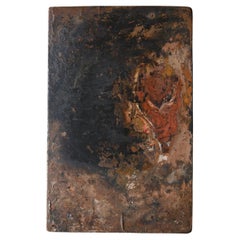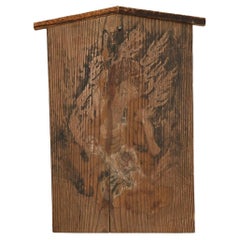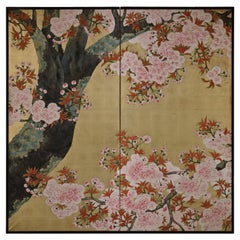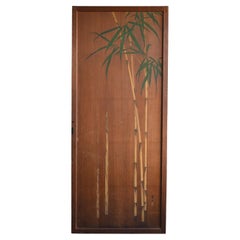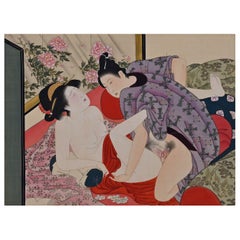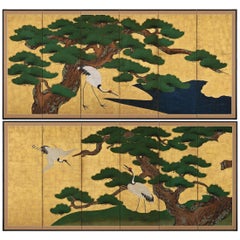Japanese Paintings
to
18
241
40
328
4
3
Height
to
Width
to
7
5
2
1
1
46
120
162
7
75
41
11
11
1
10
4
1
5
5
1
204
166
135
125
108
13,579
9,816
6,349
5,591
3,014
335
335
335
2
2
2
2
1
Place of Origin: Japanese
Wooden work board of an old Japanese lacquerware craftsman/wall hanging object
Located in Sammu-shi, Chiba
This is a workbench used by a lacquerware craftsman around the Showa era. Originally, it was a workbench with drawers, but the drawer portion has been lost, leaving only the top boar...
Category
20th Century Showa Japanese Paintings
Materials
Wood
Antique woodblock painting of a Myo-o king/Edo period painting/wall decoration
Located in Sammu-shi, Chiba
This is a Buddhist painting on board, estimated to have been painted around the Edo period (1603-1868). The plate depicts a Myoo image similar to Zao Gongen or Fudo Myoo, with his ri...
Category
18th Century Edo Antique Japanese Paintings
Materials
Cedar
Early 20th Century Japanese Cherry Blossom Screen by Kano Sanrakuki
Located in Kyoto, JP
Cherry Blossoms
Kano Sanrakuki (1898-1981)
Showa period, circa 1930
2-panel Japanese Screen
Color, gofun and gold leaf on paper
Against a backdrop of gold-leafed ground, the lichen covered trunk and branches of the life-sized cherry blossom tree reach out and beyond the confines of the pictorial surface. The overall composition has a feeling of flatness which draws emphasis to the surface and the three-dimensionality of the cherry blossoms. Painstakingly built-up layers of thickly applied shell-white gofun detail the voluminous blossoms and cover large areas of this tour-de-force of Japanese Nihonga painting. By simplifying the background, minimizing the number of colors and depicting the blossoms with such heavy relief, the artist has emphasized the stunning presence of the cherry tree. The type of tree depicted is the Yae-Zakura; a double-layered type of cherry blossom famed for its beauty and strength. When we think of Japanese cherry blossoms, the first thing that comes to mind is Somei Yoshino variety, which has a single flower with five almost white petals. This type is fragile and easily blown away by strong wind or rain. Most of the double-flowered cherry blossoms begin to bloom when the Somei-Yoshino falls, and the flowering period lasts longer than that of the Somei-Yoshino.
Kano Sanrakuki originally studied painting at the Kyoto City Arts and Crafts School under the tutelage of Yamamoto Shunkyo...
Category
Early 20th Century Showa Japanese Paintings
Materials
Gold Leaf
Wooden door with old Japanese bamboo painting/Wall hanging painting/Wooden door
Located in Sammu-shi, Chiba
This is a one-panel wooden door made in Japan around the 20th century. The material used is presumed to be Japanese cypress or Japanese cedar, and the delicately straight grain of th...
Category
20th Century Taisho Japanese Paintings
Materials
Cedar
19th Century Japanese Shunga Hand-Scroll, Katsukawa School
Located in Kyoto, JP
Shunga
Unknown artist
Meiji era, circa 1880
Hand-scroll mounted with 12 paintings
Ink, pigment and gofun on silk
Dimensions:
Each image measures H. 23.2 cm x W. 34.4 cm (9.15” x 13.5”)
The hand-scroll measures H. 28 cm x W. 540 cm (11” x 212”)
A set of 12 late 19th century Japanese Shunga paintings mounted as a hand-scroll. Two of the leaves bear the signature and seal ‘Setsuzan’, although we are unable to confirm the identity of the artist using this art name. 6 of the 12 images are taken almost directly from Katsukawa Shuncho’s late 18th century woodblock series, ‘Erotic Pictures...
Category
Late 19th Century Meiji Antique Japanese Paintings
Materials
Silk
Circa 1700 Japanese Screen Pair, Cranes & Pines, Kyoto Kano School
Located in Kyoto, JP
Pines and Cranes
Anonymous. Kyoto Kano School.
Late 17th/early 18th centuries, circa 1700.
Pair of six-panel Japanese folding screens.
Ink, gofun, pigment and gold leaf on paper.
This bold composition presents two pine trees extending to the left and right across a gold leaf background. One tree is silhouetted against a green ground, golden clouds obscuring its true size, the other stretches across a stylized waterway. The pines are paired with Manchurian cranes with red crests and snow white plumage. Both have been highly auspicious motifs in East Asia since Chinese antiquity. Here the artist utilized fluid and instinctive ink brushstrokes to define the trunk, branches and tail feathers, in strong contrast to the precision and sharp angularity of the crane’s legs and beaks. The adoption of this vast metallic painting support required an unerring sense of design and composition, so that the negative space surrounding motifs could imply context for the otherwise floating pictorial elements. The brushwork detailing the trunks of the pines, the exaggerated dimensions of the pine trees and the strength and dynamism of the composition are all reminiscent of Kano Eitoku...
Category
Late 17th Century Edo Antique Japanese Paintings
Materials
Gold Leaf
Early 19th Century Japanese Screen. Cherry Blossom & Pheasants by Mori Tetsuzan
Located in Kyoto, JP
Mori Tetsuzan (1775-1841)
Pheasants and Cherry Blossoms
Two-fold Japanese screen. Ink, color, gofun, gold and silver on paper.
A two-fold Japanese bir...
Category
Early 19th Century Edo Antique Japanese Paintings
Materials
Gold Leaf
Large Japanese 2-Panel Byôbu 屏風 'Room Divider' with Painting of Bamboo & a Poem
Located in Amsterdam, NL
Beautiful, large two-panel byôbu (room divider) with a serene painting of red-leaved bamboo and rocks on an oxidized silver leaf background. Silver leaf continuously undergoes the process of oxidation, which creates a beautiful aged patina.
On the left an inscription from a ‘Zekku’ poem by the Chinese poet Yang Zai (1271?1323), titled: Shan shang zhu (bamboo (painted) on a fan).
Translated as :
Why would people plant a lot of bamboos?
The shade of a single culm is also beautiful.
In the autumn night it rocks on the wind,
And the fresh sound echoes in my dream.
Dated: Shôwa, the year kôshin (1938). Signature unknown...
Category
Early 20th Century Japanese Paintings
Materials
Other, Silver Leaf
19th Century Japanese Scroll Painting, Birds & Flowers of the Four Seasons
Located in Kyoto, JP
Birds and flowers of the four seasons
Early to mid-19th century
Ink, pigment and gofun on silk
Unidentified artist
Signature: S...
Category
1830s Edo Antique Japanese Paintings
Materials
Silk
Japanese Screen, Early 20th Century Wagtail & Chrysanthemum by Ishizaki Koyo
Located in Kyoto, JP
Ishizaki Koyo (1884-1947)
Wagtail & Chrysanthemum
Early 20th century
Folding screen in two-panels. Ink, pigments and gofun on gold leaf.
Sign: Koyo
Seal: Koyo
This ...
Category
Early 20th Century Taisho Japanese Paintings
Materials
Gold Leaf
Japanese Screen Painting, circa 1700 'Horses' by Kano Tanshin
Located in Kyoto, JP
Horses
Kano Tanshin Morimasa (1653-1718)
Two-panel tea-ceremony Japanese screen or furosaki
Ink on gold leaf,
late 17th-early 18th century
Measures: H 55 cm x W 182 cm
The Kano school was closely aligned with the warrior class in Japan. The samurai, who lived in a closed and rigid hierarchical society established by the Shogunate, were drawn to the energy and freedom horses symbolize; Kano school artists commonly depicted the equine creatures as they are here, in unfettered and carefree family groups. China originally introduced horse paintings to Japan; the works typically focused on capturing the essence of horses in their various environments and often involved integrating human figures into the images.
Kano Tanshin Morimasa (1653-1718) was the son of Kano Tanyu...
Category
1690s Edo Antique Japanese Paintings
Materials
Gold Leaf
Meiji Era Japanese Two Panel Hand Painted Wood Table Screen Tale of Genji
Located in Studio City, CA
A Meiji era Japanese two-panel wood screen, with illustrated images from The Tale of Genji that are exquisitely painted directly on wood with fine detail and precision, accented with scattered 24k gold leaf specks in cloud forms, rendered in the manner of Heian period...
Category
19th Century Meiji Antique Japanese Paintings
Materials
Gold Leaf
Japanese Framed Silk Painting, Turtledoves and Peaches, Taisho Era, circa 1920
Located in Kyoto, JP
Nakamura Daizaburo
Turtledoves in a Peach Tree
Taisho period, circa 1920
Framed painting. Mineral pigments, ink and gofun on silk
Signed: Daizaburo
Dimensions (framed)...
Category
1910s Taisho Vintage Japanese Paintings
Materials
Wood, Silk
19th Century Japanese Scroll Painting by Igarashi Chikusa, Poppies & Butterflies
Located in Kyoto, JP
Poppies & Butterflies
Ink, pigment and gofun on silk
Igarashi Chikusa (1774-1844)
Signature: Chikusa Ran Zen
Upper Seal: Ran Shuzen
Lower Seal: Kyoho
Dimensions:
Scroll: H. 68” x W. 18” (172cm x 45cm)
Image: H. 38.5’’ x W. 12.5’’ (98cm x 32cm)
This composition shows elegant images of poppies and the butterflies that are inevitably drawn to them. It captures a momentary glimpse into a world both visually dazzling and startlingly realistic. The painting is infused with sensitivity and attention to seasonal change and weather conditions. The thin and fragile poppies are beautifully depicted with brilliant colors and the butterflies are similarly infused with life. The painting is on silk which requires extremely precise painting skills as no element once painted can be removed.
Poppies were a favorite subject of Rinpa school artists through the ages. Originally they were somewhat abstracted but by the age of Sakai Hoitsu...
Category
Early 19th Century Edo Antique Japanese Paintings
Materials
Silk
Early 20th Century Japanese Willow and Ducks Byobu Screen
Located in Chicago, IL
This early 20th-century Japanese byobu screen captures a serene moment in nature, with a large willow tree casting its graceful branches over a secluded cove. Three playful ducks gat...
Category
Early 20th Century Taisho Japanese Paintings
Materials
Gold Leaf
Japanese Hand-Painted Silk Artwork of a Seated Concubine in Giltwood Frame
Located in Yonkers, NY
Japanese hand-painted silk artwork depicting a seated concubine in an intricate kimono, framed in a custom giltwood frame. This vintage piece captures a quiet moment of contemplation...
Category
Mid-20th Century Japanese Paintings
Materials
Silk, Wood, Paper
Mid-18th Century Japanese Screen Pair, One Hundred Flowers, Chrysanthemums
Located in Kyoto, JP
Omori Soun (b. 1704)
Chrysanthemums - One Hundred Flowers
A Pair of Six-fold Japanese Screens. Ink, color, gofun and gold leaf on paper.
Dating ...
Category
Mid-18th Century Edo Antique Japanese Paintings
Materials
Gold Leaf
17th Century Japanese Screen Pair by Soga Nichokuan, Hawks on Pine & Plum Trees
Located in Kyoto, JP
Hawks on plum and pine
Soga Nichokuan (active circa 1625-1660)
Pair of six-fold screens.
Ink, mineral pigments, gofun, gold and speckled gold l...
Category
1640s Edo Antique Japanese Paintings
Materials
Wood, Paper
Early 20th Century Japanese Screen Pair - Ink Pine Trees on Gold
Located in Kyoto, JP
Imao Keisho (1902-1993)
Pine Trees
Early 20th Century, Circa 1930
Pair of six-panel Japanese screens. Ink on silk and gold leaf.
Dimensions: Each screen H. 67.5” x 148” (172 cm x 376 cm)
A pair of monumental six-panel Japanese pine screens by the renowned Nihonga artist Imao Keisho. Here Keisho entirely removed the background and brought the pine trees to the surface of the painting. This simplification of the elements makes the scene exceptionally direct and compelling and injects a very modern...
Category
Early 20th Century Showa Japanese Paintings
Materials
Gold Leaf
19th Century Japanese Edo Six Panel Kano School Landscape Screen
Located in Rio Vista, CA
Late Edo period 19th century Japanese six-panel landscape screen featuring a cypress tree over a flowering hibiscus with a pair of hototogisu birds. Kano school painted with ink and ...
Category
19th Century Edo Antique Japanese Paintings
Materials
Silk, Wood, Paper
19th Century Japanese Screen Pair. Flowers & Birds of the Four Seasons
Located in Kyoto, JP
Flowers & Birds of the Four Seasons
Pair of six-fold Japanese Screens. Ink, color, gofun and gold on paper.
Second half of the 19th Centur...
Category
Late 19th Century Meiji Antique Japanese Paintings
Materials
Wood, Paper
Meiji Era, Circa 1900 Japanese Screen Pair, Flowers & Birds of Spring & Autumn
Located in Kyoto, JP
Flowers & Birds of Spring and Autumn
Unknown artist.
Japan. Meiji period, circa 1900.
A pair of six-fold screens. Ink, color, gofun and gold leaf on paper.
Signed: Gaga S...
Category
1890s Meiji Antique Japanese Paintings
Materials
Gold Leaf
18th Century Japanese Floral Paintings, Set of 5, Mineral Pigments on Gold Leaf
Located in Kyoto, JP
A set of 5 Japanese floral paintings from the 18th century. Each painted with mineral pigments directly applied to gold leaf. They were originally designed to be mounted on the leave...
Category
Mid-18th Century Edo Antique Japanese Paintings
Materials
Gold Leaf
Japanese Folding Screen Six Panels Painted on Gold Leaf
By Japanese Studio
Located in Brescia, IT
Paravento a sei pannelli di scuola giapponese Kano: paesaggio con bellissime ed eleganti gru vicino al fiume, con alberi di pino e sakura.
Dipinto a mano con pigmenti minerali ed inc...
Category
Early 19th Century Edo Antique Japanese Paintings
Materials
Gold Leaf
Pair of Japanese Edo Six Panel Screens the Seven Sages
Located in Rio Vista, CA
Fantastic pair of 19th century Japanese late Edo/early Meiji period six-panel screens titled The seven sages of the bamboo grove. The Kano school screens...
Category
19th Century Edo Antique Japanese Paintings
Materials
Brass, Gold Leaf
Japanese Shows 4 Panel Screen, Ducks in Autumn
Located in Delray Beach, FL
Enhance your decor with this exquisite Japanese 4-Panel Screen featuring Ducks in Autumn. The serene scene is beautifully rendered, capturing the essence of nature in traditional Jap...
Category
Mid-20th Century Japanese Paintings
Materials
Wood
Japanese Miniature Four-Panel Screen Blue and Green Landscape
Located in Rio Vista, CA
19th century mid-Edo period Japanese four-panel miniature screen. Depicting a beautifully painted Chinese blue and green landscape in the Nanga School...
Category
19th Century Edo Antique Japanese Paintings
Materials
Brass
Jirokichi Kasagi Japanese Watercolor On Silk Painting
Located in New York, NY
Jirokichi Kasagi, 1870 to 1923, an antique Japanese watercolor on silk painting depicting a young Japanese lady wearing a beautiful traditional at...
Category
Late 19th Century Antique Japanese Paintings
Materials
Paint
Japanese Screen Painting, Early 19th Century, Autumn Flowers by Sakai Hoitsu
Located in Kyoto, JP
A two-fold Japanese screen by the Rimpa school artist Sakai Hoitsu (1761-1828), Japan, 19th century, Edo period.
This small Japanese folding screen pai...
Category
Early 19th Century Edo Antique Japanese Paintings
Materials
Wood, Silk
17th Century Japanese Screen Pair. Tiger & Dragon by Kaiho Yusetsu
Located in Kyoto, JP
Kaiho Yusetsu (1598-1677)
Tiger and Dragon
Early Edo Period, Circa 1650
A Pair of Six-fold Japanese Screens. Ink and slight color on paper.
Dimensions:
Each screen: H. 171 cm x W. 380 cm (67.5’’ x 149.5’’)
In this pair of early Edo period Japanese screens a group of tigers prowl in a bamboo grove whipped with fierce wind, while a dragon claws through clouds and mist. The dragon embodies elemental qualities - looming out of the mist, the coils of its body disappearing in the clouds. The dragon is calling for rain, symbolizing spring which is considered the fountain of life. On the other side, the tigers calls for the wind, symbolizing autumn which is considered the end of life. Tigers were familiar motifs within Japanese art from ancient times though the animals were imaginary to the people in the 17th century. While dragons and tigers are usually associated as sacred and ferocious, in this painting, both animals have rather amusing expressions. The tigers appear to glare at the dragon with cat-like eyes, and the look on the swirling dragon’s face appears almost affectionate - lending a playful flair to an otherwise magnificent theme.
The tiger and dragon are cosmological symbols of the balancing forces in the world. Screens such as this were originally meant to express the fluctuating nature of the world. For Japanese in the early Edo period, they likely suggested the powers of the cosmos. In Japan the tiger and dragon motif was originally absorbed into the circles of Zen monasteries before spreading into the secular world. The theme especially appealed to the military classes with the Kano school, the official painters to the Shogun and the samurai, being the leading contributors. The painter of this pair of screens, Kaiho Yusetsu (1598-1677), was closely patronized by the third Shogun Tokugawa Iemitsu. In his later years he worked with Kano school artists...
Category
Mid-17th Century Edo Antique Japanese Paintings
Materials
Silk, Wood, Paper
Japanese Showa Period Peacocks Painted on Silk
Located in Rio Vista, CA
Colorful Japanese ink and color on silk Showa painting of a pair of peacocks. Vivid colors and beautiful details with a signature and seal on right side bottom. Framed in a midcentur...
Category
20th Century Showa Japanese Paintings
Materials
Silk, Plexiglass, Paper, Wood
17th Century Japanese Screen. Ink Plum Tree & Birds by Kano Naonobu.
Located in Kyoto, JP
Kano Naonobu (1607-1650)
Plum Tree and Birds
Six-fold Japanese Screen. Ink and slight color on paper.
In this evocative ink work spread over a six-panel folding screen, we see the consummation of the elegance and refinement of the Edo Kano school. This 17th century screen is a rare surviving example of a large-scale bird and flower painting by Kano Naonobu, the younger brother of Kano Tanyu...
Category
17th Century Edo Antique Japanese Paintings
Materials
Wood, Paper
Japanese Screen Painting, Circa 1700 'Tales of Ise' by Tosa Mitsusuke
By Tosa Mitsusuke 1
Located in Kyoto, JP
A six-fold Japanese screen by Tosa Mitsusuke (1675-1710), Japan 17th-18th century, Edo period.
The signature reads Shoroku-i ge Tosa sa Konoe Shogen Mit...
Category
Late 17th Century Edo Antique Japanese Paintings
Materials
Gold Leaf
Japanese Meiji Two Panel Screen Geese and Reeds
Located in Rio Vista, CA
Fantastic Japanese late Meiji period two-panel byobu screen by Hashimoto Koshu. The large screen features two white geese amid brightly colored reeds. The symbolism of geese and reeds was introduced to Japan from China in the 13th century. This was a popular subject for Japanese zen artists of the period. Beautifully crafted with exceptional brush strokes and details. Made with natural pigments in dramatic vivid colors of white, pink, and mint green on a silk background of gilt. Circa 1900 with artist seal on bottom right corner. Koshu studied Western art under...
Category
20th Century Meiji Japanese Paintings
Materials
Silk, Wood, Paper
Set of Four Japanese Silk Hanging Scrolls Screens C.1920
Located in London, GB
A stunning set of four Japanese silk mounted vertical hanging scrolls.
Dating from C.1920 Taisho Period.
The watercolour and ink on silk depicts a larg...
Category
1920s Japonisme Vintage Japanese Paintings
Materials
Silk
Japanese Painting. Bird and Flower. 19th century copy of Lu Ji by Ogata Tomin.
Located in Kyoto, JP
Ogata Tomin (1839 -1895)
Birds in a spring landscape
Ink and colour on silk.
Inscription reads:
“Copy of Lu Ji, painted with heartfelt appreciation”
“Painted by Tomin Ogat...
Category
Late 19th Century Ming Antique Japanese Paintings
Materials
Silk
Set of Four Japanese Fusuma Painted Door Panels
Located in Rio Vista, CA
Rare set of four Japanese Showa period door panels known as Fusuma in Japanese architecture. Similar to a Shoji room divider but made of an opaque materia...
Category
20th Century Showa Japanese Paintings
Materials
Brass
Japanese Edo Six Panel Screen Yoshitsune and Benkei
Located in Rio Vista, CA
Spectacular 19th century Japanese late Edo period six-panel byobu screen depicting Yoshitsune and Benkei, two heroes of Japanese folklore. Crafted in ink and natural color pigments on mulberry paper with thick gold leaf borders on each panel. The character Yoshitsune is seated under a blossoming cherry tree in full armor holding a fan. The warrior priest or monk Benkei is depicted kneeling on a leopard skin...
Category
19th Century Edo Antique Japanese Paintings
Materials
Brass, Gold Leaf
Six-Panel Japanese Screen on Spring Gold Leaf
Located in Brescia, IT
Spring landscape by an unknown painter of the Rinpa school, 19th century, six-panel ink painted on gold leaf on rice paper.
The flowers are made with the "gofun" technique, natural or pigmented white oyster powder.
Rinpa (? ?, Rinpa) is one of the major historical schools of Japanese painting. the style was consolidated by the brothers Ogata Korin (1658–1716) and Ogata Kenzan...
Category
Late 19th Century Edo Antique Japanese Paintings
Materials
Gold Leaf
Sophisticated Mid-Century Modern Japanese Abstract Painting by Yoshio Minomura
Located in Hopewell, NJ
Sophisticated and fascinating original painting by Japanese artist Yoshio Minomura having abstract composition with hieroglyphic like scribbles.
Minomura gained his diploma from t...
Category
1960s Mid-Century Modern Vintage Japanese Paintings
Materials
Canvas
Japanese Showa Two Panel Screen Blossoming Prunus Tree
Located in Rio Vista, CA
Serene Japanese Showa period two-panel folding byobu screen depicting a large spring blossoming prunus tree or plum tree. Beautifully painted with ink and natural color pigments on m...
Category
20th Century Showa Japanese Paintings
Materials
Brass
Japanese Silver Screen Pair, Meiji Period, Herons & Plovers, Shijo School
Located in Kyoto, JP
Heron & Plovers
Ink and silver leaf on paper
Maekawa Bunrei (1837-1917)
A pair of low six-panel Japanese screens by Maekawa Bunrei, a later master of the Kyoto based Shijo school of painting. On the right screen a solitary white heron stands motionless in a stream. On the left screen plovers play along a shoreline. The elegant forms are executed employing fluid, minimalistic ink brushstrokes. The soft brushstrokes and the sharp light of the silver leaf lend the scenes a sense of translucence. The sophisticated composition superbly exploits the long, horizontal pictorial surface of the pair of folding screens...
Category
Early 1900s Meiji Antique Japanese Paintings
Materials
Silver Leaf
Early 20th Century Pair of Japanese Folding Screens, Deer Under Maple Trees
Located in Kyoto, JP
Deer under maples
Late Taisho period, circa 1925-1930
Pair of two-panel screens. Ink and pigment on silk.
Signature: Goho
Seal: Goho
A pair of two-fold Japanese silk screens...
Category
1920s Taisho Vintage Japanese Paintings
Materials
Wood, Paper, Silk
A rare wooden sliding door with Japanese paintings/1800-1920/Edo-Meiji
Located in Sammu-shi, Chiba
This is a wooden sliding door produced in Japan from the late Edo period to the Meiji period. This piece, which must have watched over people's lives for many years, is more than jus...
Category
19th Century Edo Antique Japanese Paintings
Materials
Cypress
Japanese Painting, Hanging Scroll, Mid 19th Century, Koi and Water Plants
By Iwase Hirotaka
Located in Kyoto, JP
Iwase Hirotaka (1808-1877)
Koi and Water Plants
Hanging scroll, ink, color, gold wash and gold flecks on silk
Inscription: Hirotaka
Seal: Ille...
Category
1860s Edo Antique Japanese Paintings
Materials
Silk
Antique Work Board Used by Japanese Craftsmen/1868-1920/Wabi-Sabi Wall Painting
Located in Sammu-shi, Chiba
If you want something special, we recommend purchasing items selected by Brood.
We sell carefully selected old Japanese items.
I've seen tens of thousands of items so far.
Based o...
Category
Late 19th Century Meiji Antique Japanese Paintings
Materials
Cedar
19th Century Japanese Screen for Tea-Ceremony, Ink Bamboo and Plum on Gold Leaf
Located in Kyoto, JP
Three Friends of Winter
Nakajima Raisho (1796-1871)
Late Edo period, circa 1850
Ink and gold leaf on paper.
This is a double-sided Japanese Furosaki or tea-ceremony screen from the mid 19th century; bamboo and plum on the front, young pines the back. It by Nakajima Raisho, a master painter of the Maruyama school in the late Edo and early Meiji periods. In this work Raisho combines exquisite ink brushwork with large open spaces of brilliant gold-leaf to inspire the viewers imagination. Rather than naturalism, he is searching for the phycological impression of the motifs, resulting in abstraction and stylization. His simplification of the motifs the result of looking to capture the inner nature of the objects. This art motif is known as Sho Chiku Bai, or the Three Friends of Winter. Evergreen pine connotes steadfastness, bamboo suggests both strength and flexibility, while plum blossoms unfurling on snow-laden branches imply hardiness. Combined, this trio is emblematic of Japanese new year. Chinese literati were the first to group the three plants together due to their noble characteristics. Like these resilient plants flowering so beautifully in winter, it was expected of the scholar-gentleman to cultivate a strong character with which he would be able to show the same degree of perseverance and steadfastness even during times of adverse conditions.
The screen would have been placed near the hearth of a room used for the Japanese tea ceremony, shielding the fire from draughts and also forming a stimulating and decorative backdrop behind the tea utensils. It would have been used in the Hatsugama, or first tea-ceremony of the new year.
Nakajima Raisho (1796-1871) originally studied under Watanabe Nangaku before entering the school of Maruyama Ozui. He was the highest ranking Maruyama school painter at the end of the Edo period and was known as one of the ‘Four Heian Families’ along with Kishi...
Category
Mid-19th Century Edo Antique Japanese Paintings
Materials
Gold Leaf
Japanese Showa Six Panel Screen Manchurian Crane Bamboo Grove
Located in Rio Vista, CA
Enchanting Japanese Showa period six-panel byobu screen titled "Bamboo Forest-Immortal Together". The large screen depicts six manchurian cranes in a ...
Category
20th Century Showa Japanese Paintings
Materials
Brass
Japanese Edo Two Panel Screen Deities by Yokoyama Kazan
Located in Rio Vista, CA
Whimsical Japanese late Edo period two-panel screen circa 1800 by Yokoyama Kazan (Japanese 1784-1837). The screen depicts four of the seven Gods or deities ...
Category
19th Century Edo Antique Japanese Paintings
Materials
Brass, Gold Leaf
Contemporary Japanese Abstract Calligraphy by Dai Okumura
Located in Chiba, JP
Indian ink on old Japanese paper, 62 x 102 cm. Some creases.
Category
2010s Japonisme Japanese Paintings
Materials
Paper
Japanese Six Panel Kano School Winter Landscape Screen
Located in Rio Vista, CA
Large Japanese Meiji period six-panel screen depicting a winter landscape with a Chinese sage visiting friends in a country villa. Ink and vivid color pigments on mulberry paper mounted to a gilt background. Painted in the 19th century Kano school...
Category
19th Century Meiji Antique Japanese Paintings
Materials
Metal
Japanese Screen of Spring on Gold Leaf
Located in Brescia, IT
It is a two-panel screen from the Taisho period, around 1920, beautifully painted in excellent detail.
The best of Rinpa's school painting: large empty space that highlights a pair of mandarin ducks in the middle of the pond.
On the right, flying birds give the painting a great lightness, under many multicolored flowers they celebrate spring.
All very proportionate and pleasant, the dimension really interesting.
Mineral pigments on gold leaf. It turns out Anonymous.
Lucio Morini.
Category
Early 20th Century Taisho Japanese Paintings
Materials
Gold Leaf
Japanese Painting, Framed Panel, Willow and Sparrows, circa 1920 Taisho era
Located in Kyoto, JP
Anonymous
Summer willow and sparrows
Taisho period, circa 1920
Framed painting. Mineral pigments, mica, gold, ink and gofun on silk
Dimensions (framed):
H. 98 cm x W. 135 cm x D...
Category
1920s Taisho Vintage Japanese Paintings
Materials
Wood, Silk
Japanese Bijin-ga Painting of Woman in Period Kimono, Taisho Period, circa 1920
Located in Prahran, Victoria
Rare Japanese Taisho period Bijin-ga style painting of a beautiful woman in period kimono holding a fan, circa 1920.
Bijin-ga is a Japanese term used to describe paintings or pict...
Category
1920s Taisho Vintage Japanese Paintings
Materials
Silk
Japanese Painting, Framed Panel, Dahlias and Roosters, circa 1920
Located in Kyoto, JP
Tanaka Tessen (b.1890)
Dahlias and Roosters
Taisho period, circa 1920
Framed painting. Mineral pigments and ink on silk.
Dimensions (framed):
H. 159 cm x W. 97 cm x D. 2.5 cm (62.5” x 38” x 1”)
An ornate and complex composition in which the artist explores almost the entire painting surface. The coloration is bold and evocative and the tinted silk ground recreates the warm golden glow of sunset. Soft, luminous brushwork details the black feathers of the roosters, which seem to cloud and blur in counterpoint to the sharper points of the eyes and beaks. Their brilliant red combs balance the composition, echoing the rich burgundy hues of the dahlias; the flowers exquisite and lifelike. Dahlias were an exotic subject favored by painters of the Taisho era.
The painting belongs to the school of Kyoto Nihonga, exemplifying the principles of decorative elegance and consumate brush technique with which it was intimately associated. Painters of the time relied on the Shijo school method, basing the forms of the composition from life sketches. Sometimes they were then integrated with elements derived from Chinese bird and flower...
Category
1920s Taisho Vintage Japanese Paintings
Materials
Silk, Wood
Miçao Kono - "Woman with Cat" (1934) - Huile sur toile
By Micao Kono
Located in NEUILLY-SUR-SEINE, FR
Miçao Kono - "Woman with Cat" (1934)
Type : Huile sur toile
Signature : Signée et datée 1934 en bas à gauche et au dos de l’œuvre
Encadrement : Exceptionnel cadre Art Déco en marqu...
Category
Mid-20th Century Art Deco Japanese Paintings
Materials
Paint
Fine Japanese Brush Painting of Cherry Blossom Festival
Located in Greenwich, CT
Fine Japanese brush painting of cherry blossom festival, ink and color on silk, 19th century, museum conservation framed.
Overall size: 68" hi...
Category
1880s Meiji Antique Japanese Paintings
Materials
Silk
Japanese Two Panel Screen: Pomegranate Tree
Located in Hudson, NY
With various flowers, manderin ducks and garden stone accented with gold leaf on ground surface. Nagasaki School Painting.
Category
Mid-19th Century Antique Japanese Paintings
Materials
Silver Leaf
